|
Earth Day 2012:
Call to save endangered planet
By Pramod DE SILVA
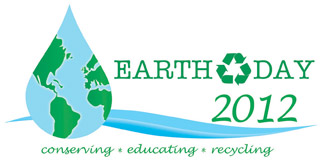 We have only one home - Planet Earth. We are not advanced enough
(yet) to venture to worlds beyond, which might offer us another liveable
habitat. Thus we have to live here at least for thousands of years to
come. However, that will only be possible if we protect Mother Earth. We have only one home - Planet Earth. We are not advanced enough
(yet) to venture to worlds beyond, which might offer us another liveable
habitat. Thus we have to live here at least for thousands of years to
come. However, that will only be possible if we protect Mother Earth.
Yet, we hear so many stories about Man's destructive attitudes
towards the Earth. We cut down its forests; drive its flora and fauna to
extinction; pollute its seas and rivers; emit noxious gases to its
atmosphere; dump non-decaying products everywhere. If these activities
go on, the Earth might not survive.
This is why there is a dire need to listen to the Earth's stories and
come forward to protect it. This is the aim of the Earth Day, which has
been celebrated every year on April 22 since 1970. Today, more than one
billion people around the globe will participate in Earth Day 2012 and
help "Mobilize the Earth".
"Mobilize the Earth" is the theme of this year's Earth Day. Today,
people of all nationalities and backgrounds will voice their
appreciation for the planet and demand its protection. Their message?
"Together we will stand united for a sustainable future and call upon
individuals, organisations, and governments to do their part".
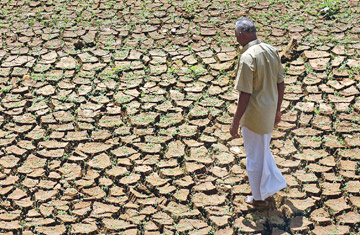 |
|
Pic: Sudam Gunasinghe |
According to Earth Day Network, the organisers of Earth Day 2012, "as
the 42nd Anniversary of Earth Day approaches, people are becoming
frustrated with the failure of governments to take any steps toward
protecting and preserving the environment.
The Earth Day 2012 campaign is designed to provide people with the
opportunity to unite their voices in a call for a sustainable future and
direct them toward quantifiable outcomes".
Earth Day 2012 will thus act as a launch pad for the environmental
movement and will put forth a bold declaration demanding immediate
action to secure Renewable Energy for All and a sustainable future for
our planet.
The movement will call upon local, national, and international
leaders to put an end to fossil fuel subsidies, embrace renewable energy
technology, improve energy efficiency, and make energy universally
accessible. One can also take part in the Billion Acts of Green campaign
to contribute to the Earth's well-being.
Global referendum
Under this campaign, organisations, businesses and governments can
voice their support by performing environmental actions and lending
their names to this global referendum demanding change.
The goal is to reach one billion actions by the time the United
Nations Conference on Sustainable Development (Rio+20) is held in June
2012.
Campaign for Communities is another Earth Day program that acts as a
platform for leaders around the world to engage their communities in
discussions about the challenges and opportunities related to
sustainability. Looking back, Earth Day marks the anniversary of what
many consider the birth of the modern environmental movement in 1970.
The idea came to Earth Day founder Gaylord Nelson, then a US Senator
from Wisconsin, after witnessing the ravages of the 1969 massive oil
spill in Santa Barbara, California.
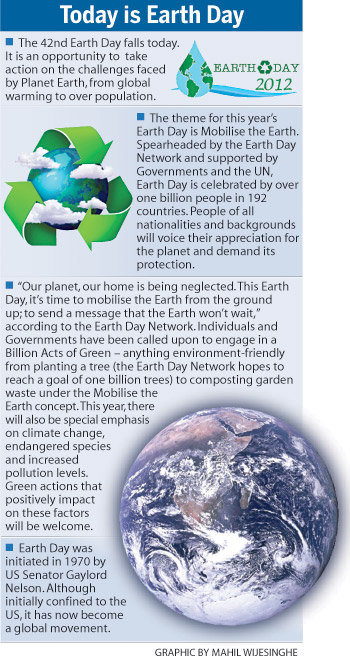 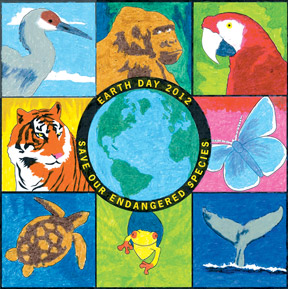 Inspired by the student anti-war movement, he realised that if he
could infuse that energy with an emerging public consciousness about air
and water pollution, it would force environmental protection onto the
national political agenda. Inspired by the student anti-war movement, he realised that if he
could infuse that energy with an emerging public consciousness about air
and water pollution, it would force environmental protection onto the
national political agenda.
His efforts culminated in a show of environmental solidarity by 20
million Americans who took to the streets, parks, and auditoriums to
demonstrate for a healthy, sustainable environment in massive
coast-to-coast rallies.
Thousands of colleges and universities organised protests against the
deterioration of the environment. Groups that had been fighting against
oil spills, polluting factories and power plants, raw sewage, toxic
dumps, pesticides, freeways, the loss of wilderness and the extinction
of wildlife suddenly realised they shared common values.
Passage of Acts
In the US alone, the first Earth Day led to the creation of the
United States Environmental Protection Agency and the passage of the
Clean Air, Clean Water, and Endangered Species Acts. By 1990, the Earth
Day had become a global movement, mobilising 200 million people in 141
countries and lifting environmental issues onto the world stage.
By 2000, a record 5,000 environmental groups in 184 countries reached
out to hundreds of millions of people, with the message that Earth is
worth saving. Moreover, the Internet was entering mainstream usage
around this time and the campaign gained additional strength through
that medium.
Earth Day 2010, the 40th anniversary, reinforced Earth Day as a
powerful focal point. Earth Day Network amassed 40 million environmental
service actions toward its 2012 goal of A Billion Acts of Green,
launched an international one million tree planting initiative with
Avatar director James Cameron and tripled its online base to over
900,000 community members.
Today, the Earth Day encompasses every nation on Earth, big and
small, rich and poor.
We usually think that only governments have to be responsible for
looking after the environment and hence the earth. Nothing could be
further from the truth.
This is the idea behind the Billion Acts of Green campaign. Even a
small act - from planting a tree to recycling a plastic container - by
an individual helps.
Even replacing an incandescent bulb with an LED or fluorescent bulb
can make a big difference in the end. US scientists have estimated that
if every 60-watt incandescent bulb in the US was replaced with a 10-watt
LED/fluorescent bulb, the country would save about 35 terawatt-hours of
electricity, the equivalent electricity of 17.5 electric power stations,
or $3.9 billion in one year.
Moreover, the change will also avoid 20 million metric tons of carbon
emissions, or the equivalent to removing nearly four million cars from
the roads.
That is the power of one small measure, magnified by the population
of a given country. Just imagine the scale of the positive impact on the
environment if everyone around the world replaced their incandescent
bulbs.
Renewable energy
There will be a huge emphasis on renewable energy this year, because
these technologies are now going mainstream. With renewable energies
such as wind and solar coming to the fore, talking about
'sustainability' is no longer an option, all need to take individual and
collective responsibility towards 'living sustainably'. And that means
living without damaging the fragile environment.
Another factor is the need to protect the planet's rich flora and
fauna. It is true that new species are being discovered every day, but
the rate at which species are going extinct is rather alarming. Some
species are down to only a handful of individuals in the wild.
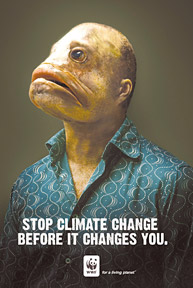 We have to act before they too become as dead as the Dodo. Do we
really want to see a world without elephants, tigers, polar bears or
pandas? We have to act before they too become as dead as the Dodo. Do we
really want to see a world without elephants, tigers, polar bears or
pandas?
Climate change has become a major issue, especially in the light of
the forthcoming Rio Summit. Man's own actions have resulted in phenomena
such as global warming, which could mean a drastic temperature and sea
level rise that could threaten especially the coastal and island
communities.
We have altered the cycles and patterns of nature by cutting down
forests and polluting rivers. Agriculture too is facing a crisis because
the amount of arable land is becoming limited.
In October last year, the world population exceeded seven billion.
This means that the resources of our world have to be shared by all
seven billion of us.
We might be able to overcome this challenge, but only if we strike a
balance between consumption and conservation.
Living sustainably while protecting and nurturing the Earth is the
only possible - and viable - answer. Today, Earth Day, is a golden
opportunity to ponder on these issues and to be committed to save our
endangered planet.
|

